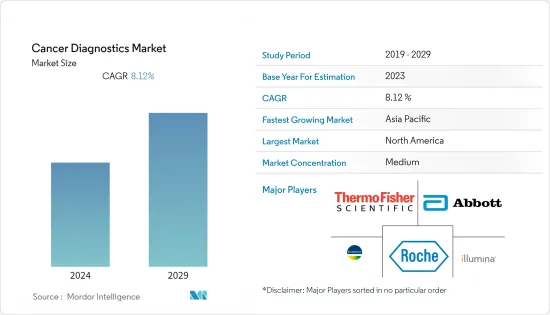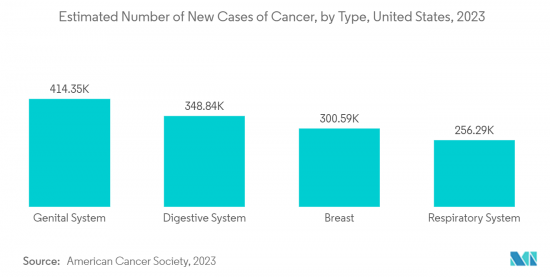PUBLISHER: Mordor Intelligence | PRODUCT CODE: 1404091

PUBLISHER: Mordor Intelligence | PRODUCT CODE: 1404091
Cancer Diagnostics - Market Share Analysis, Industry Trends & Statistics, Growth Forecasts 2024 - 2029

The Global Cancer Diagnostics Market size is expected to grow from USD 106.24 billion in 2024 to USD 156.97 billion by 2029, at a CAGR of 8.12% during the forecast period.
The COVID-19 pandemic has led to substantial reductions in new cancers being diagnosed. According to the data from PubMed published in May 2021, researchers found a 31% decrease in new referrals for colorectal cancer during the 1st wave of the pandemic, relative to the average of the previous two years. Cancer patients were particularly vulnerable to the disruption of their care as diagnosis through endoscopy was halted due to concerns about virus transmission. Therefore, it was found that COVID-19 had a significant impact on the market studied. However, with the relaxation of all restrictions related to COVID-19, the market studied has reached its pre-pandemic level growth in terms of diagnostic procedures being performed for cancer and is expected to witness healthy growth over the forecast period.
The key factors driving the market growth include the rising prevalence of cancer worldwide, increasing ease of cancer diagnosis, and the advancements in cancer diagnostics in the area of biomarkers and point-of-care diagnosis.
An increase in the number of cancer cases and the rise in the geriatric population are the major factors contributing to the growth of the cancer diagnostics market globally. According to Canadian Cancer Society data updated in November 2022, about 233,900 people were living with cancer in Canada in 2022. The Globocan estimated that globally, there will be more than 30 million people living with cancer by the year 2040. Thus the high burden of cancer worldwide is expected to propel market growth in the coming years.
Furthermore, age is a significant risk factor for developing cancer. For instance, the American Society of Clinical Oncology data updated in January 2021, reported that most colorectal cancer cases were observed in people older than 50 years of age. The average age for colon cancer diagnosis in men is 68 years and 72 years for women. For rectal cancer, the average age for colon cancer diagnosis is 63 for both men and women in the United States. The same source stated that only 11% of all patients diagnosed with colorectal cancer are under 50 years old. The data published by the Centers for Disease Control and Prevention (CDC) in February 2022 also highlighted that the risk of colorectal cancer increases with aging. Hence, the geriatric population is likely to be utilizing screening tests for colorectal cancer, which is anticipated to boost market growth over the forecast period.
However, stringent regulatory framework, lack of universal health coverage, and expensive diagnostic procedures are the few factors restraining the growth of the cancer diagnostics market globally.
Cancer Diagnostics Market Trends
The Diagnostic Imaging Tests Segment is Expected to Hold a Major Share in the Cancer Diagnostics Market
The most commonly used screening test for cancer is diagnostic imaging tests. The different kinds of imaging techniques for cancer detection, like imaging (radiology) tests for cancer such as CT scans, MRI, nuclear medicine scans, ultrasound, mammograms, X-rays, and other radiographic tests, are considered the most reliable ones.
There have been several technological advancements in diagnostic imaging for cancer which are enabling segmental growth. For instance, in March 2022, a new imaging device for breast cancer detection and monitoring was developed by students at the University of Notre Dame. The device was named NearWave Imager and it can detect breast cancer in women. Such efforts being taken to develop new imaging devices for cancer diagnosis are expected to contribute to segment growth.
Besides, mammograms are the most widely used tests to diagnose cancers. Mammography is the gold standard technique used to screen breast cancer. Governments and other healthcare organizations worldwide are partnering to develop an effective diagnostic tool for the provision of access to mammography screening to women between 50 and 75 years. For instance, in October 2022, the American College of Radiology (ACR) launched the Contrast-Enhanced Mammography Imaging Screening Trial (CMIST) in collaboration with the Breast Cancer Research Foundation (BCRF) and GE Healthcare. The trial was to determine whether contrast-enhanced mammography improves breast cancer detection and reduces false-positive exams in women with dense breasts.
Furthermore, the development of new technologically advanced products for cancer diagnosis is expected to support market growth. For instance, in November 2021, Siemens Healthineers launched Naeotom Alpha, the globe's first photon-counting CT Scanner with improved resolution as well as a reduction in radiation dose by up to 45% for ultra-high resolution scans.
Thus, the segment is expected to show significant growth over the forecast period.

North America is Anticipated to Observe a Significant Growth in the Global Cancer Diagnostics Market
North America is expected to majorly contribute to the cancer diagnostics market growth. The market is majorly driven by the increasing burden of cancer across the countries such as the United States and Canada and the rising focus of medical device companies to develop new diagnostic devices that can detect cancer.
According to the American Cancer Society's (ACS) Statistics, the number of new cancer cases is likely to increase from 1,918,030 in 2022 to 1,958,310 by 2023 in the United States. Besides, breast cancer is considered to be the most prevalent type of cancer among women and the number of cancer cases is projected to reach 300,590 in 2023 from 290,560 in 2022. Similarly, the number of colon cancer is likely to reach 81, 860 in 2023 from 80,690 in 2022. This high prevalence of colorectal cancer is creating a need for more screening tests to reduce the burden of the disease. This drives the growth of the market studied.
Additionally, the initiatives taken by the government in this region are expected to accelerate market growth. For instance, in January 2022, President Biden announced a reignition of the Cancer Moonshot, highlighting new goals which are focused on reducing the cancer death rate by half within 25 years and improving the lives of people with cancer and cancer survivors. Also, the government is supporting cancer diagnosis drives which are believed to contribute to market growth.
Cancer Diagnostics Industry Overview
The cancer diagnostics market is highly fragmented with the presence of a large number of local and international players. Key players are adopting different growth strategies to enhance their market presence such as partnerships, agreements, collaborations, new product launches, geographical expansions, mergers, and acquisitions. Some of the key players in the market are Abbott Laboratories, F. Hoffmann-La Roche Ltd, Thermo Fisher Scientifica Inc., and Qiagen.
Additional Benefits:
- The market estimate (ME) sheet in Excel format
- 3 months of analyst support
TABLE OF CONTENTS
1 INTRODUCTION
- 1.1 Study Assumptions and Market Definition
- 1.2 Scope of the Study
2 RESEARCH METHODOLOGY
3 EXECUTIVE SUMMARY
4 MARKET DYNAMICS
- 4.1 Market Overview
- 4.2 Market Drivers
- 4.2.1 Increasing Government Initiatives
- 4.2.2 Increasing Burden of Cancer Globally
- 4.2.3 Emergence of New Technologies Such as Biomarkers and Point of Care Testing
- 4.3 Market Restraints
- 4.3.1 Limited Use in the Emerging Markets
- 4.3.2 Expensive Diagnostic Procedures
- 4.4 Porters Five Force Analysis
- 4.4.1 Threat of New Entrants
- 4.4.2 Bargaining Power of Buyers/Consumers
- 4.4.3 Bargaining Power of Suppliers
- 4.4.4 Threat of Substitute Products
- 4.4.5 Intensity of Competitive Rivalry
5 MARKET SEGMENTATION (Market Size by Value - USD million)
- 5.1 By Diagnostic Type
- 5.1.1 Diagnostic Imaging Tests
- 5.1.2 Biopsy and Cytology Tests
- 5.1.3 Tumor Biomarkers
- 5.1.4 Other Diagnostic Types
- 5.2 By Application
- 5.2.1 Breast Cancer
- 5.2.2 Lung Cancer
- 5.2.3 Cervical Cancer
- 5.2.4 Kidney Cancer
- 5.2.5 Liver Cancer
- 5.2.6 Pancreatic Cancer
- 5.2.7 Ovarian Cancer
- 5.2.8 Other Applications
- 5.3 Geography
- 5.3.1 North America
- 5.3.1.1 United States
- 5.3.1.2 Canada
- 5.3.1.3 Mexico
- 5.3.2 Europe
- 5.3.2.1 Germany
- 5.3.2.2 United Kingdom
- 5.3.2.3 France
- 5.3.2.4 Italy
- 5.3.2.5 Spain
- 5.3.2.6 Rest of Europe
- 5.3.3 Asia-Pacific
- 5.3.3.1 China
- 5.3.3.2 Japan
- 5.3.3.3 India
- 5.3.3.4 Australia
- 5.3.3.5 South Korea
- 5.3.3.6 Rest of Asia-Pacific
- 5.3.4 Middle East and Africa
- 5.3.4.1 GCC
- 5.3.4.2 South Africa
- 5.3.4.3 Rest of Middle East and Africa
- 5.3.5 South America
- 5.3.5.1 Brazil
- 5.3.5.2 Argentina
- 5.3.5.3 Rest of South America
- 5.3.1 North America
6 COMPETITIVE LANDSCAPE
- 6.1 Company Profiles
- 6.1.1 Abbott Laboratories Inc.
- 6.1.2 F. Hoffmann-La Roche Ltd
- 6.1.3 Siemens Healthineers
- 6.1.4 Thermo Fisher Scientific Inc.
- 6.1.5 GE Healthcare
- 6.1.6 Hologic Inc.
- 6.1.7 Illumina Inc.
- 6.1.8 Bio-Rad Laboratories Inc.
- 6.1.9 Agilent Technologies Inc.
- 6.1.10 Biomeriuex SA
- 6.1.11 Cancer Diagnostic Inc.
- 6.1.12 Myriad Genetic Laboratories Inc.
- 6.1.13 Qiagen
- 6.1.14 Agilent Technologies, Inc.
7 MARKET OPPORTUNITIES AND FUTURE TRENDS




